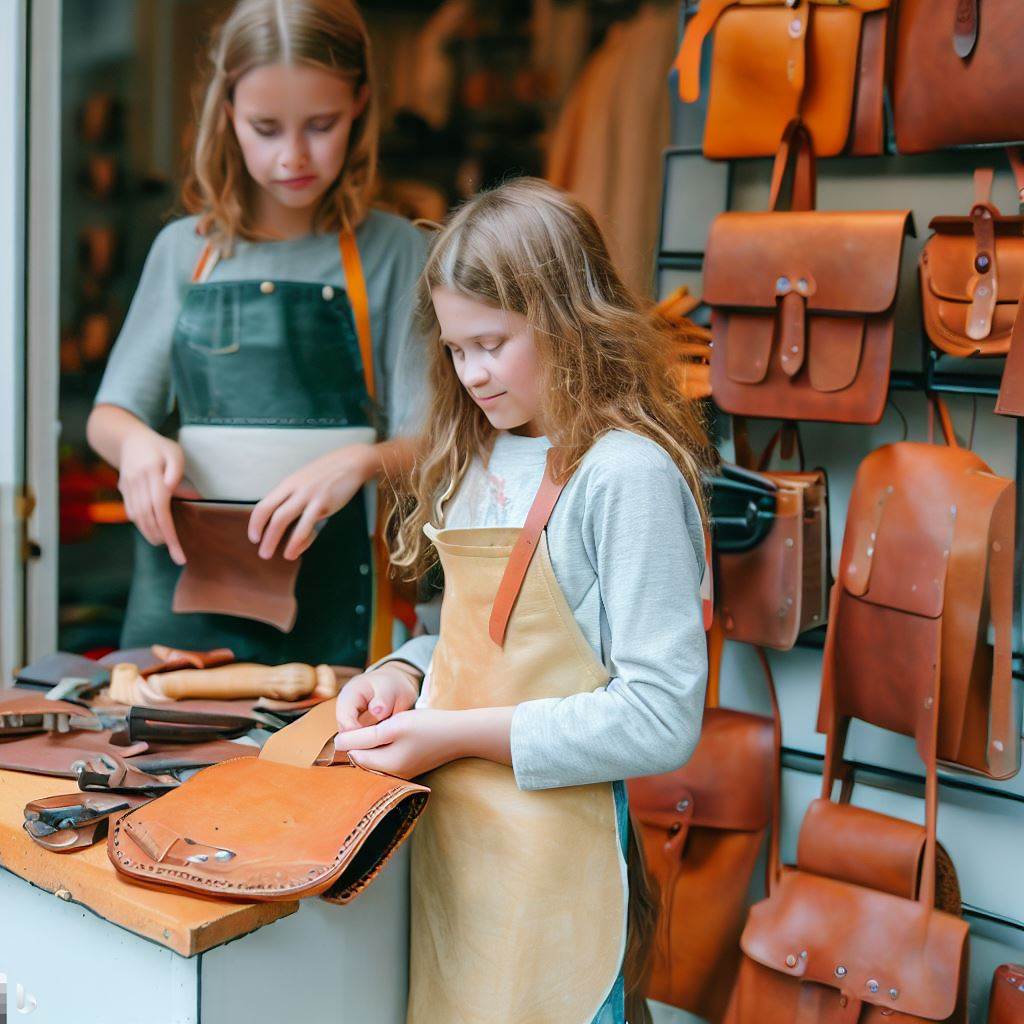Leatherworking with Kids: Fostering Creativity in Young Crafters
Age Appropriate Leather Projects for Skill Building
Leatherworking provides engaging hands-on learning for children when project complexity matches their developing motor skills. Creativity and confidence blossom through age-appropriate activities.
Ages 5-7 – Simple stamping, lacing pre-punched shapes, or gluing decorative elements like studs onto precut items.
Ages 8-10 – Making laced bracelets, keychains, coin purses. Learning basic stitching and tooling.
Ages 11-13 – Creating wallets, journals, pet collars. Advancing tooling skills and design intricacy. Learning dyeing.
Ages 14+ – Progressing to bags, apparel, uptapped items. Expanding into advanced carving, construction and modeling techniques.
Meeting kids where their dexterity and attention span allows success ensures genuine engagement and pride that build foundations for potential lifelong avocation.
Ensuring Young Kids’ Safety
Leatherworking harbors potential safety hazards requiring vigilant adult supervision when guiding young children through hands-on activities. But simple precautions foster enjoyable exploration.
Closely monitor use of sharp tools like blades, awls, stamping equipment. Require protective gloves handling dyes or chemicals. Ventilate indoor spaces. Provide adequate eye protection from debris.
Set reasonable time limits to prevent fatigue. Demonstrate proper ergonomics. Prepare kid-friendly materials avoiding toxicity. Guide them step-by-step verbally through each process.
With age appropriate ground rules, leatherworking teaches responsibility and mindfulness alongside creativity from an early supportive age.
Fostering Cultural Connections and Identity
For many indigenous or traditional communities, leatherworking carries deep cultural heritage. Involving children fosters generational bonds and historical identity.
Volunteer elders demonstrate ancestral techniques they learned from their own parents and grandparents, answering questions about customary practices, gender roles, and significance. Young hands gain context learning by elders’ sides.
Children recognize designs stemming from oral stories and clan symbols explained over the rhythmic cutting and stamping. Pride swells seeing traditions endure through their participation. Mentorship provides roots and wings.
Making Creating Academy Curriculums
Some innovative schools incorporate leather working into regular hands-on arts and shop class coursework to teach lifelong making skills and provide sensory education alternatives.
Students research cultural leather traditions, practice fundamental tool skills, and design original portfolios or marketable leather accessories as semester capstones presenting their work. Classes cover science, math, history, and art intrinsically.
The act of envisioning and incrementally transforming leather raw materials into finished products provides immense confidence and problem solving skills benefitting young minds in all domains. Doing accrues wisdom.
Scout Badges for Leathercrafting Skills
Scouts organizations frequently design badge earning programs around introductory leatherworking skills to provide kids with purposeful hands-on activities and vocational exposure. Guided learning engages creatively.
Ages 5-8 – Simple soap carving, texturing, lacing
Ages 8-11 – Stamping wallets, key fobs, basic tooling
Ages 12-16 – Dyeing, finishing, constructing journals, jewelry
Ages 16-18 – Advanced tooling skills, repairs, business basics
Checking incremental leatherworking achievements on badges motivates perseverance through initial difficulty towards mastery. Scouting develops initiative and resilience experientially.
Making Treasured Bonded Family Heirlooms
One of the most meaningful ways to involve kids in leatherworking is collaborating on keepsake heirloom gifts embedding cherished family memories for future generations.Young participation makes traditions personally relevant
Grandparents guide grandkids designing sentimental custom pieces like a recipe book cover stamped with an apron motif in honor of baking together. A family establishes annual traditions tooling ornaments celebrating each year’s highlights.
By creatively documenting important memories, children gain understanding of how handicrafts record lineage stories across generations. The lessons stick through special collaborative projects retold forever.
Teaching Sustainable Production and Ethics
From young ages, teaching future leatherworkers environmental and ethical considerations around materials sourcing fosters generational responsibility and stewardship.
Children see how using every hide scrap reduces waste. Sourcing local materials like fallen antlers for decoration minimizes shipping. Studying native flora for plant-based dyes provides botanical education.
With care, young minds appreciate how leatherworking can cherish animals, people and the planet alike. Early lessons pave the way for conscientious creative futures.
Volunteering with Orphanages and Youth Programs
Some expert leathercrafters volunteer time teaching workshops for underprivileged youth who benefit tremendously from marketable vocational skills and caring adult mentorship the training provides.
Orphanages and youth shelters worldwide have kids make simple stamped wallets and phone cases they can sell to raise funds for food, clothing and medicine. Youth art programs build community through leather.
Guiding disadvantaged teens through leatherworking projects steers them toward purposeful self-worth, empathy and possibility thinking benefiting life’s course far beyond just craft mastery. The mentoring relationships empower.
Building Dexterity and Focus Through Repetition
The patient repetitive practice required when progressing through leatherworking’s technical steps develops dexterity, determination and focus in young minds. Making fulfills youthful energy productively.
Cutting identical strips or punching long rows of holes focuses buzzing attention while building motor control. Tracing the same basketweave tooling pattern to perfection across a leather journal cover teaches perfectionism. Scraping flakes trains muscle memory.
As kids determinedly work leather, satisfaction in the incremental progress made toward completed products keeps them engaged and settles hyperactivity. Leatherwork grants confidence through developing competence.
Establishing Creative Confidence Early
Successfully designing and hand making beautiful leather goods from scratch at a young age establishes creative confidence and problem solving skills kids draw upon the rest of their lives.
They experience how much care and ingenuity it takes to craft items appearing so seamless. Having ideas manifest by working through frustrating sticking points builds resilience. Their imagination gains wings seeing visions take form.
By valuing the learning process itself over perfect results, children remain open to invention and growth. Leatherworking through setbacks early nurtures courage and resilience to create.
With the right structured support and encouragement, leatherworking awakens children to the sense of achievement, mindfulness, and purpose making beautiful useful items by hand can provide across a lifetime. The creative spirit once sparked glows bright indefinitely when fanned gently through project based learning.
